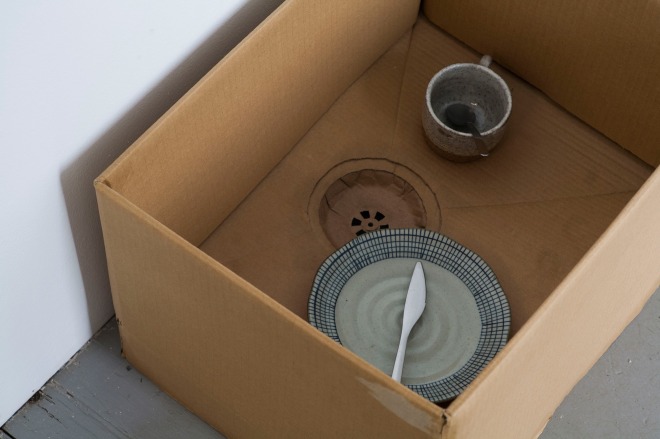
Detail from Lai Yu Tong’s exhibition It’s strange I feel like I’ve seen this one before at DECK. Photo: Chua Chye Teck
On Lai Yu Tong’s Bandcamp page, under the name cosmologists, the introduction to his music tracks reads, “Proudly made under the depressing yellow-lit nights of Singapore.”
Yu Tong longs for some distance in considering the city that frames his vision, his movements, his art, his music, the food he eats, and the exhibitions he is exposed to. I have been observing how Yu Tong has been writing his biography for zines, websites, and exhibition guides. The words he employs keep changing order; they are added, edited or taken away like in a poem or a piece of music. “Lai Yu Tong is a Singaporean artist” appears to be the one recurring sentence.
Yu Tong asks me, a foreigner working in Singapore, to help him make sense of this place. I am not sure I can, as I experience the Lion City through my European roots and nomadic work trajectory. We do however compare notes on Singapore’s urban landscape, its human fabric and its consumerist soul. He tells me about growing up with ships constantly blocking one’s view of the horizon. I tell him about coming from Italy, a country with centuries-old buildings and a visible, crumbling past.
In the exhibition Awakenings: Art in Society in Asia 1960s–1990s at the National Gallery Singapore, I notice three black and white photographs, Newspapers: After the 1st of June 1974, a work by Sung Neung-Kyoung. In the first photo the Korean artist is depicted cutting rectangular sections from a newspaper’s spread. In the second, he is holding the two pages with parts missing, the cutouts lying on a table. In the third, the newspaper is recreated by rearranging the cuttings in new positions within the holes of the missing news. This conceptual exercise highlights how easily transference of meaning and fabrication of facts can occur in different political contexts. I would also like to consider this work as a precedent to Lai Yu Tong’s Newspaper Paintings.
Yu Tong tells me he used to flip through The Straits Times as a kid, looking at the images in the newspaper, his attention taken by the colourful images of people, places and products. Today, stacks of The Straits Times, gathered from old copies obtained through his parents’ subscription or daily editions bought on the road to his studio, feed Yu Tong’s protocol. The technique the artist has perfected comprises applying coats of white paint to newspaper spreads (canvas) in a way that reveals the trace of the brush and the hand when prepping the surface (base). The medium of painting, mentioned in the title, is combined with the lightness of materials and the use of leftovers; his method requires time, patience and an eye for composition. Before working on them, the newspapers, either as pages or as cutouts, are separated in different cardboard boxes like in a domestic recycling exercise.
The Newspaper Paintings offer an alternative way of making art: re-using materials that are already in the world, a result of a self-imposed manual task attempting to counteract the artist’s (over) thinking. This series aligns in my mind to what American conceptual artist Douglas Huebler stated in 1970: “The world is full of objects, more or less interesting; I do not wish to add any more.” This non-conformist choice is particularly striking in the landscape of Singapore where throwing, rather than reusing, is prevalent.
On my latest visit to Yu Tong’s studio, after having dinner together at a local Chinese eatery, I am presented with the new works he has prepared for It’s strange I feel like I’ve seen this one before, his upcoming exhibition at Deck.
Everything is absolutely alright and perfectly fine (nothing is wrong) is a series of smiley portraits of co-workers, Singaporean families and international celebrities selected from the newspaper and arranged on shelves. The obligatory smile demanded by the photographer becomes, in the eye of the observer, an anxiety-inducing mirror.
Since I last saw the Newspaper Paintings, Yu Tong has removed some of the sequences I remembered, still I recognise images of the Hong Kong protests and of Carrie Lam. Trump appears more than once, disturbingly inescapable like the news. There are also tennis players, packaged foods, and models of Rolex wristwatches.
I see for the first time the sculptures he has previously described to me: 1:1 cardboard replicas of three items from his home, the kitchen sink, the bathroom tap and a corner step. While they have the precision of universal model toys (Yu Tong’s father used to construct furniture for his child and is the craftsman behind these objects), these are also very intimate details of the artist’s personal space and thoughts.
The sculptures are easy to dismiss because of the disposable quality of cardboard. But like most of Yu Tong’s works, the use of ordinary materials and reconfigured images is part of the artist’s ongoing process that aims to achieve moments of harmony.
Singapore, July-August 2019